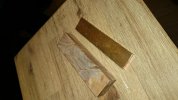DEllis
Part Time Steel Basher
- Joined
- Oct 17, 2007
- Messages
- 966
Before I start grinding the bevels I thought I would ask a couple of questions. I've never ground a swedge so I'm a little unsure of the order of operations.
My plan is to grind the main bevels first, full flat grind. Get them to 220 grit, then grind the swedge.
Any tips on grinding the swedge. Or does anyone have a link to a good video on the subject?
I grind the bevels first, and then rough the swedge in with the grinder(freehand, but you can also use a guide or jig) and then finish the swedge with a file.........slow, but it works.
Darcy





















